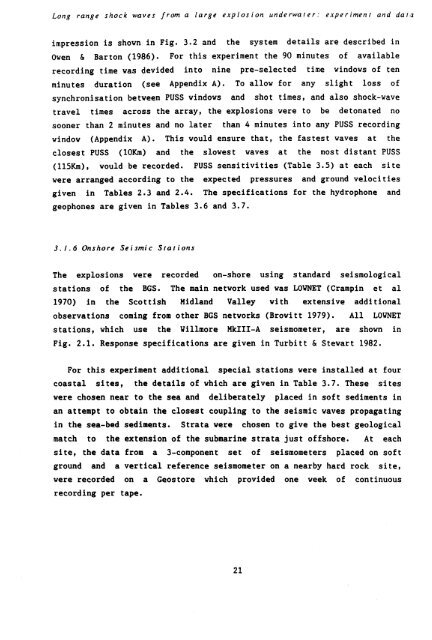Download (6Mb) - NERC Open Research Archive
Download (6Mb) - NERC Open Research Archive
Download (6Mb) - NERC Open Research Archive
Create successful ePaper yourself
Turn your PDF publications into a flip-book with our unique Google optimized e-Paper software.
Long range shock waves from a large explosion underwater: experiment and data<br />
impression is shown in Fig. 3.2 and the system details are described in<br />
Owen & Barton (1986). For this experiment the 90 minutes of available<br />
recording time was devided into nine pre-selected time windows of ten<br />
minutes duration (see Appendix A). To allow for any slight loss of<br />
synchronisation between PUSS windows and shot times, and also shock-wave<br />
travel times across the array, the explosions were to be detonated no<br />
sooner than 2 minutes and no later than 4 minutes into any PUSS recording<br />
window (Appendix A). This would ensure that, the fastest waves at the<br />
closest PUSS (10Km) and the slowest waves at the most distant PUSS<br />
(115Km), would be recorded. PUSS sensitivities (Table 3.5) at each site<br />
were arranged according to the expected pressures and ground velocities<br />
given in Tables 2.3 and 2.4. The specifications for the hydrophone and<br />
geophones are given in Tables 3.6 and 3.7.<br />
3.1.6 Onshore Seismic Stations<br />
The explosions were recorded on-shore using standard seismological<br />
stations of the BGS. The main network used was LOYNET (Crampin et al<br />
1970) in the Scottish Midland Valley with extensive additional<br />
observations coming from other BGS networks (Browitt 1979). All LOYNET<br />
stations, which use the Villmore MkIII-A seismometer, are shown in<br />
Fig. 2.1. Response specifications are given in Turbitt & Stewart 1982.<br />
For this experiment additional special stations were installed at four<br />
coastal sites, the details of which are given in Table 3.7. These sites<br />
were chosen near to the sea and deliberately placed in soft sediments in<br />
an attempt to obtain the closest coupling to the seismic waves propagating<br />
in the sea-bed sediments. Strata were chosen to give the best geological<br />
match to the extension of the submarine strata just offshore. At each<br />
site, the data from a 3-component set of seismometers placed on soft<br />
ground and a vertical reference seismometer on a nearby hard rock site,<br />
were recorded on a Geostore which provided one week of continuous<br />
recording per tape.<br />
21
















